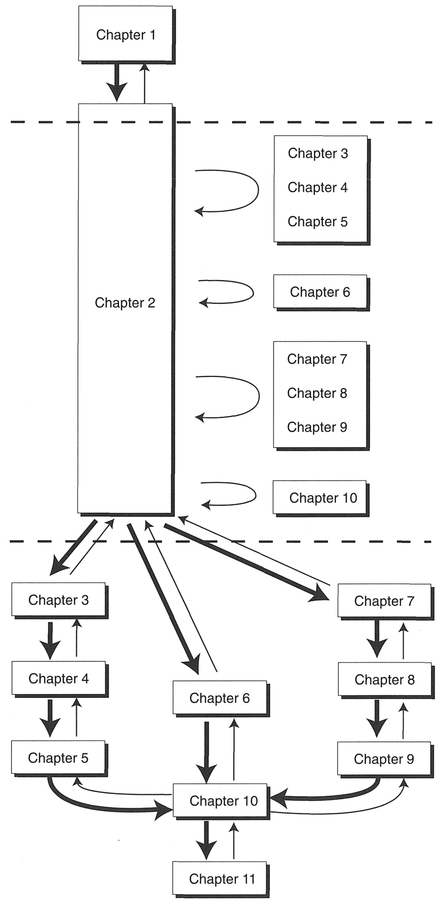
Figure i Navigating the book.
This book is concerned with the process of undertaking a research project. It is designed to guide you, the student, through all aspects of the research process, from the nurturing of your ideas and the development of a proposal, to the design of an enquiry, the generation and analysis of data, the drawing of conclusions from your results, and the presentation of your findings. In essence, the aim is to take you from a novice researcher towards being a competent investigator capable of independent enquiry.
The book has been written because, in the course of teaching and research, we have noted the absence of a single book which covered all the ingredients needed to produce a good human geography researcher. Instead we have referred students to a mixture of reference books, often with a quantitative or qualitative bias, none of which we felt to be fully adequate.
We appreciate that as novice researchers you may be apprehensive about a number of different matters. For example, you might be concerned about the generation of data, especially if it involves interviewing one or more individuals, or about the analysis or interpretation of data, or possibly the use of statistics or a computer. This book is specifically written with these concerns in mind. As any seasoned academic will tell you, research is never simple or easy; there are always problems that need to be solved or hurdles to clear. Even experienced, professional researchers can become unstuck, or encounter totally new situations that hinder their progress. However, with foresight, appropriate planning and the right skills, the majority of problems encountered can be overcome in a sensible and uncomplicated manner. As we demonstrate throughout this book, the task need not be as daunting as it might seem at first. Research can be challenging, but it can also be rewarding and exciting.
We have taken some care to try to make all the description and explanation as simple as possible, and to use detailed step-by-step examples derived from real research in human geography to provide essential background knowledge and structure to your learning experience. Many types of research and research techniques are covered, but as with any book that tries to cover the whole breadth and depth of research in a discipline, certain compromises have had to be made. This book is no exception. We provide a broad overview of the theoretical underpinnings and detail some of the main research methodologies currently being used in contemporary human geography. We refer you to other texts where appropriate. As with any textbook, it is only advice that can be given - the best source of understanding and learning is through actually doing research. This book will guide you around some of the worst pitfalls and give you sufficient practical advice to get you started. Ultimately, we claim responsibility for the content of the book and any remaining errors or oversights.

Figure i Navigating the book.
This book is designed to be both comprehensive and easy to follow. It can be either read as a linear text (i.e., starting at the beginning and reading to the end) or dipped into selectively. What is relevant will depend on the nature of your research project, and doubtless portions of the text will be inappropriate in this context. Although the exact route will be up to you, our suggested method of use is outlined schematically in Figure i. We advise that you read the whole of Chapters 1, 2 and 10. These chapters cover material that is central to all projects. The remaining chapters should be visited twice, first when reading Chapter 2 and then again whilst actually generating and analysing your data. The first visit is to help ensure that the project is planned rigorously. All stages of a project need to be considered before data is generated and analysed so that problems that might be encountered at a later date can be identified and strategies to combat them implemented. The second visit will help guide you through the details of implementing specific techniques.
The data sets that we use as examples can all be downloaded from Pearson Education's web site: http://www.awl-he.com (you will need to search for this book and the companion web site is linked from the marketing page there), as can GASP (a computer package that has been written to perform spatial statistics). All the data sets are named as their respective table number in the text (e.g., the data in Table 4.1 is saved in the file Table41.dat).